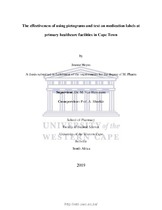| dc.contributor.advisor | Van Huyssteen, M | |
| dc.contributor.author | Heyns, Jeanne | |
| dc.date.accessioned | 2020-10-20T07:57:46Z | |
| dc.date.available | 2020-10-20T07:57:46Z | |
| dc.date.issued | 2020 | |
| dc.identifier.uri | http://hdl.handle.net/11394/7372 | |
| dc.description | Magister Pharmaceuticae - MPharm | en_US |
| dc.description.abstract | Medication labels are often the only information available to patients after obtaining medication 3 from the pharmacy or other healthcare practitioners. Inappropriately designed medicine labelling 4 contributes to poor interpretation and improper use, which could adversely affect patient health 5 outcomes. In developing countries, pictograms (pictures representing words or phrases), on 6 medicine labels tend to support patients’ ability to read, understand and recall information. 7
8
Objective 9
This comparative study examined low-literate participants’ interpretation of ‘text-and-pictogram’ 10 instructions versus ‘routine text-only’ instructions relative to the intended medicine use 11 instructions on an oral rehydration (OR) dry mixture sachet in public sector Community Health 12 Centres (CHCs) in Cape Town | en_US |
| dc.language.iso | en | en_US |
| dc.publisher | University of the Western Cape | en_US |
| dc.subject | Cape Town | en_US |
| dc.subject | Tygerberg | en_US |
| dc.subject | Community health center | en_US |
| dc.subject | Medication | en_US |
| dc.title | The effectiveness of using pictograms and text on medication labels at primary healthcare facilities in Cape Town | en_US |
| dc.rights.holder | University of the Western Cape | en_US |

